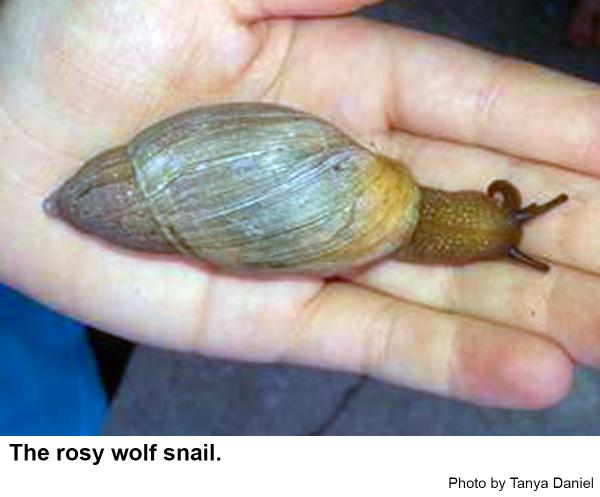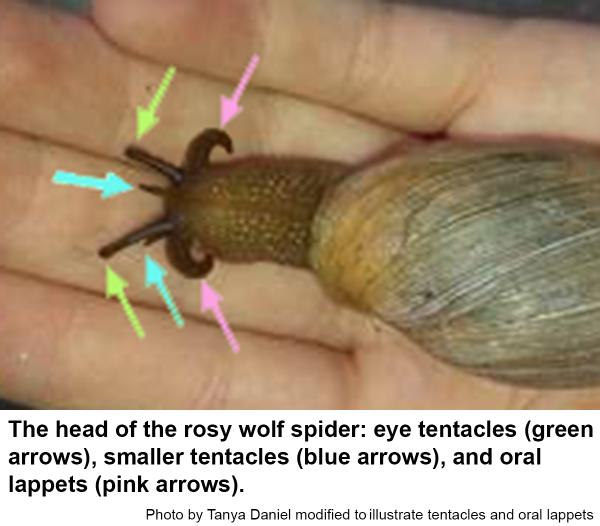Description and Biology
The rosy wolf snail is a of medium-sized to large land snail that feeds on other species of snails and slugs. It is also called the cannibal snail because at times it eats other rosy wolf snails and eggs. Sometimes slugs can fend off rosy wolf snails by thrashing about. This species is native to tropical North America. It has become an invasive species in many other places, including Hawaii where it has caused many native snail species to go extinct. The rosy wolf snail has a long, light brown, reddish brown or grayish shell, and the body is light gray to reddish brown. The shell of some specimens can reach 2.75 inches long and the body can reach 4 inches when stretched out! Its lower tentacles are short and almost touch the ground. The two upper, long tentacles have eyes at the tips and are three times longer than the lower tentacles. Rosy wolf snails also have two oral lappets that have chemical receptors, which allow rosy wolf snails to follow the slime trails of their victims. Rosy wolf snails move at least three times faster than most snails so they easily overtake their prey snails and slugs. They readily crawl up vertical surfaces in pursuit of prey. Rosy wolf snails use their necks to hold larger prey while they stick an eversible esophagus into the prey's shell, minces it up, and sucks out the insides of the unfortunate victim. Sometimes smaller snails are ingested whole. Rosy wolf snails can even go under water to pursue prey. These snails sometimes burrow under mulch and boards or plywood on the soil. After a rain, they may gather in small numbers to mate. Each snail may consume 350 snails and slugs during its 24 month life span. Adults lay 25 to 35 eggs in a shallow pocket in the soil that hatch after 30 to 40 days.
.
Habitat
The rosy wolf snail is found in gardens and landscapes, especially areas where slugs and snails are found. These snails sometimes burrow under mulch and boards or plywood and they even pursue their prey into water. After a rain, rosy wolf snails may gather in small numbers to mate.
Residential Recommendation
Because they feed on snails and slugs that feed on plants, rosy wolf snails can be considered beneficial to landscapes and gardens. No control seems necessary for rosy wolf snails (unless you are concerned about preserving native molluscs!).
References
- Common name: snail-eating snails of Florida, scientific name: Gastropoda. Auffenberg, K., L. A. Stange, and T. R. Fasulo. 2001 (revised 2011). Featured Creatures, Entomology & Nematology, FDACS/DPI, EDIS. Pub. No. EENY-251.
- Euglandina rosea. Anonymous. 2013. Wikipedia, the free encyclopedia.
- Rosy Wolf Snail, Euglandina rosea (Férrusac, 1821). Anton, M. 2010. MolluskMan.com, The Website for Houston Mollusks.
- The Rosy Wolf Snail (Euglandina rosea). Robert Nordsieck , R. 2011. The Living World of Molluscs.
- Extension Plant Pathology Publications and Factsheets
- Horticultural Science Publications
- North Carolina Agricultural Chemicals Manual
For assistance with a specific problem, contact your local Cooperative Extension Center.
This Factsheet has not been peer reviewed.
Publication date: Oct. 14, 2013
Reviewed/Revised: Oct. 12, 2019
N.C. Cooperative Extension prohibits discrimination and harassment regardless of age, color, disability, family and marital status, gender identity, national origin, political beliefs, race, religion, sex (including pregnancy), sexual orientation and veteran status.


